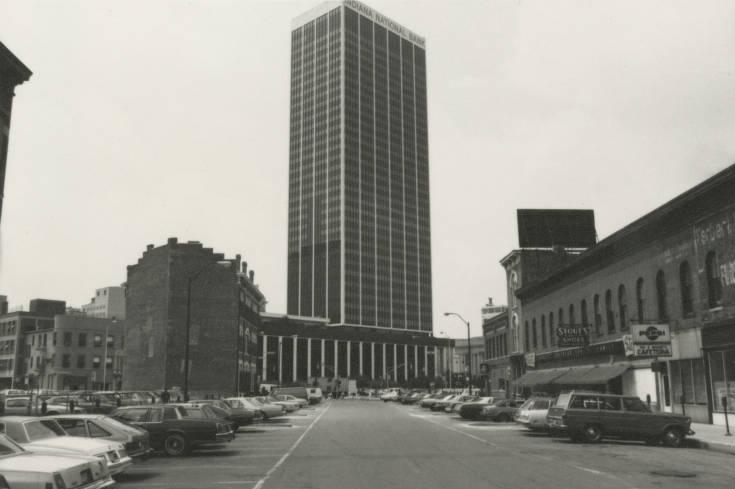The Regions Tower, first known as (INB) Tower opened in 1970 on the site of the Pythian Building, which was demolished in 1967. Designed by Thomas E. Stanley (a Dallas-based architect known for his modernist glass and steel designs), the structure sits on the south half of the block bounded by Pennsylvania, Ohio, Delaware, and New York streets.

The 33-story aluminum, glass, and marble tower rises from the northeast section of its 4-story colonnaded base to a height of 1,221 feet above sea level. By 1974, several thousand slabs of exterior Italian marble had to be reattached. In 1982, Vermont marble was installed, better suited to Indiana’s temperatures. Besides the Indiana National Bank offices, the structure housed a heliport, an observation tower, an auditorium, office space, an 8-level parking garage, several shops, and restaurants. Its walls were a gallery of American artists born after 1834 (the bank’s founding date). Until completion of the (then AUL Tower) in 1982, it was the state’s tallest building. The INB Tower was sold to JMB Realty Company of Chicago in 1983.
Over the years numerous changes have altered the tower. At one time the LOVE sculpture, a statue of Mercury and two goddesses from atop the bank’s old building at 3 Virginia Avenue, and a fountain graced the north plaza. Later a wire-sculpture bison, the bank’s logo, sat there. The tapestry Volutes, designed in 1959 by Spanish artist Pablo Picasso, was removed during the marble lobby’s 1982 remodeling.
In 1992 following INB’s acquisition by NBD Bank, a year-long renovation began and metal panels replaced the marble between the 5th and 36th floors. Atop the tower, a band of blue light under an extended cornice highlighted on the east and west facades by a band of white light replaced the Indiana National Bank name. Seven vertical strips of white light extend between the cornice and lighted medallions on the 34th floor.
Following NBD’s acquisition by Bank One in 1998, Union Planter’s Bank took over the building as its Indianapolis headquarters. The building was known as Union Planter’s Tower until Regions Financial Corporation acquired Union Planter’s in 2004.
After tornado-strength winds damaged the building on Apr. 2, 2006, the exterior of the building again underwent renovation. Gensler, a global architecture firm headquartered in San Francisco, designed the most recent facade, which is a largely transparent light blue curtain wall lighted with a LED system.

Help improve this entry
Contribute information, offer corrections, suggest images.
You can also recommend new entries related to this topic.